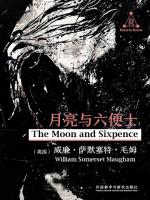月亮与六便士读后感
Written by William Somerset Maugham in 1919, The Moon and Sixpence is a story about pursuing dreams. Strickland is a dull stockman who possesses a good wife and two children. But one day, he abandons everything he has owned and goes to Paris with a painting dream. During the journey as a painter, he suffers from poverty and disease. He keeps roaming and finally settles in a tropical island Tahiti. Several years later, he dies of leper, with all his art works burned down.
In this book, the author tries to discuss the confliction between ideal and reality. The moon is as a symbol of the remote, beautiful dream, while the sixpence is the real life. The author characterizes Strickland to express his purpose, who makes an absolute break from the secular life most people are satisfied with. Before running away, Strickland possesses a happy family, high social status and good financial situation. But he throws them away with no hesitation. He keeps making subtraction on his identity and life. He refuses to act as a husband, a father, a good citizen, a successful man. It is painting that orders all of his life.
Maybe we will say Strickland is selfish and awful, as he rejects shouldering responsibility in the society. However, it is also no denying that he is poor and innocent. Because it is the destiny chooses him instead of he chooses the style of his life. He says: ”I have got to paint. I can’t help myself. When a man falls into the water it doesn’t matter how he swims, well or badly: he’s got to get out or else he’ll drown.” Strickland doesn’t gain fame or wealth through painting when he is alive. Instead, pursuing his dream is like pursuing his misfortune. He loses everything that ordinary people cherishing and lives in another level that is too far from us. The prototype of Strickland is Paul Gauguin, but Strickland is a purer genius because the author thoroughly cuts off the ambiguous boundary between the moon and sixpence.
It is a widespread creed that the success can combine both dream and reality perfectly. So the consequence is that maybe everyone in our lives has tried to measure the relationship between moon and sixpence. However, it’s not that easy to master this problem. I’d like to take myself as an example about how to handle reality and dream.
I take great interest in painting since I am a little girl, and fortunately, I am also good at it. My parents are in favor of my hobby and they sent me to a drawing class to gain more professional skills. After an eight-year-training, I generally master Chinese painting as well as calligraphy. But when I am into the third year of junior high school, I quit it in order to make full use of my time to prepare for the approaching examination. And in high school, I am too busy to paint any more. When I consider which university to apply after the college entrance examination, a senior in my drawing class encourages me to apply Academy of Fine Arts, who reluctantly abandons this plan and goes to university as a law student. But both of my parents and I consider there are too much uncertainty on art students. Therefore I become a business student though my ideal job is becoming an illustrator.
Personally speaking, everyone will encounter a dilemma that reality conflicts your dream. And most ordinary people like me may choose reality since we are not sure whether we can earn a good living on the basis of ideal.
However, the innate artists like Strickland won’t hesitate between reality and ideal. They just resolutely quit pursuing material life, which is too cruel for most people. Maybe other people will sympathize them as they are poor and tired, but themselves are rich in mental world.
All in all, the author uses The Moon and Sixpence as a reflection of the pursuit of ideal when the mainstream admires material in the society. But I don’t think we need to pity ourselves when we put reality in the prior place. It just because we are ordinary people, before we appreciate the moon, we need to make sure we have hold the sixpence.



 京公网安备 11010802032529号
京公网安备 11010802032529号